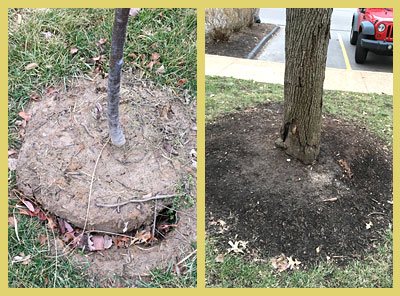Tim’s Tips – Successful planting and care of trees
1. Make sure the tree you’re planting is suitable for the conditions.
Ask yourself:
- Is this tree right for this zone?
- How much sunlight does it need?
- What is the mature size of the tree? Does it have enough room to grow?
- Is the soil type suitable?
- Can I provide the right amount of water?
- Does the site have good drainage? If not, can this tree tolerate sitting in water?
2. Apply 2-4 inches of mulch or compost in at least a 3 foot in diameter circle around the tree. Keep mulch 4″ away from the bark and don’t make a mulch volcano – aim for a donut shape rather than a volcano shape. You can mulch all the way out to the drip line or beyond if you want to – this will reduce competition from grasses or other plants and help the tree grow faster.
3. When planting the tree, the top of the root ball should be planted 4″ above the ground, but no more. Dig the hole at least twice as wide as it is deep.
4. If the root ball is wrapped in burlap that has been treated to not decompose or is synthetic, remove the burlap. Otherwise loosen burlap from around the trunk, and spread out but do not remove. Cover burlap with soil or mulch so it does not wick moisture away.
5. Cut all ropes around the root ball, natural or synthetic.
6. When transporting a tree in the bed of a truck or trailer, cover it with a tarp so that it doesn’t get dried out. Don’t let the tree sit under a tarp in the sun for an extended time. Don’t grab the trunk to lift up the root ball.
7. If planting a tree susceptible to sun scald, protect it by wrapping the trunk with a light colored wrap or painting it white with latex paint.
8. Protect the trunks of small trees from rabbits and deer.
9. Don’t hit the trunk with weed eaters or lawn mowers. Mulch can help make sure machinery doesn’t get too close.
10. Be aware of what pests and diseases your tree is susceptible to and treat if necessary.
11. Get a soil test and feed your tree with fertilizer if necessary. Don’t use more chemical fertilizer than you need. An excess of organic fertilizer is unlikely to do any harm.
12. Don’t prune without a specific purpose in mind and follow the pruning timing and techniques best for the tree species you have. Pruning is not the same for all trees and every tree doesn’t necessarily need it. Do prune out dead wood and look for structural problems that need correcting – much easier to do when the tree is small.
